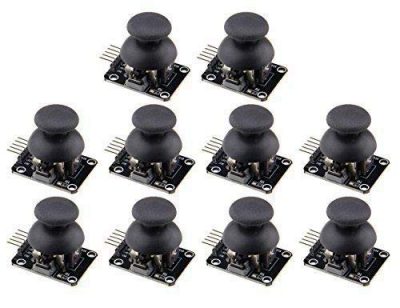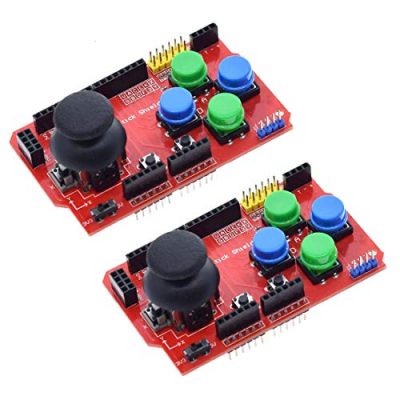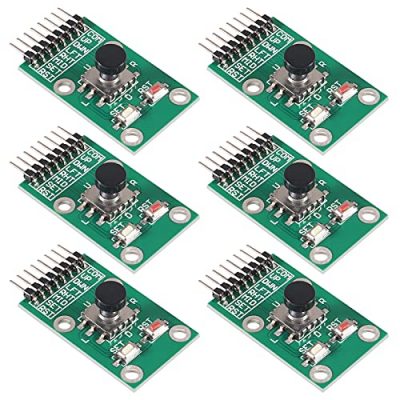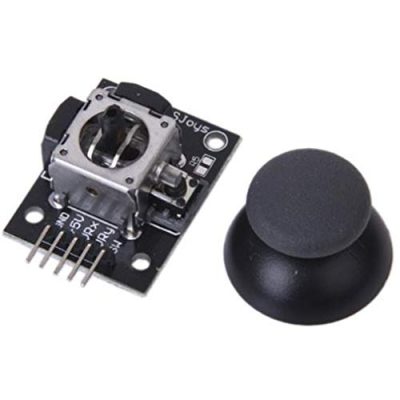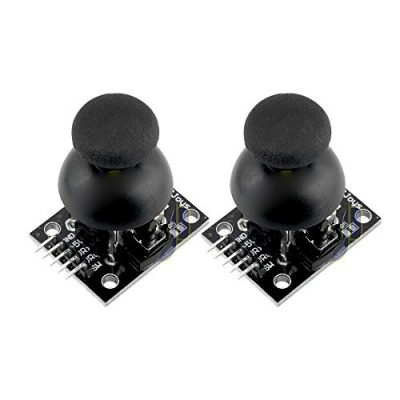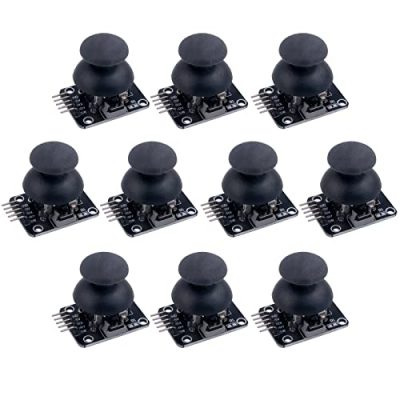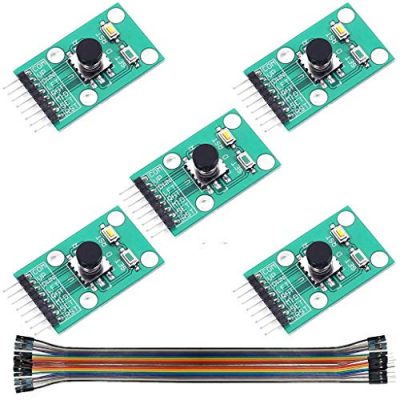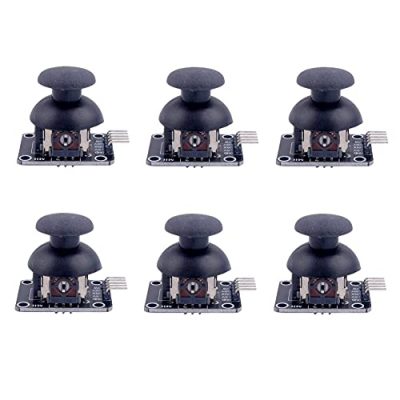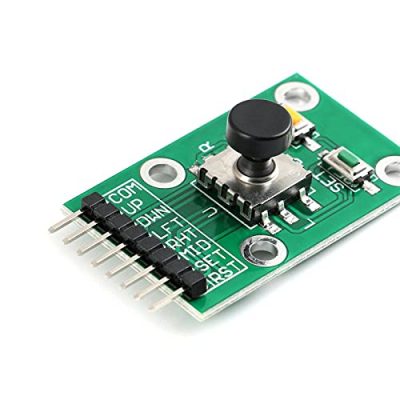Are you in search of the best Arduino joystick module for 2023? Look no further! In this article, we will unveil the top 10 Arduino joystick modules that are bound to enhance your projects and take them to new heights. Whether you are a hobbyist, a student, or a professional, having the right joystick module is crucial for precise control and immersive gaming experiences. Discover the latest advancements and features these modules offer, and make an informed decision that caters to your specific needs. Get ready to revolutionize your Arduino projects with the 10 best Arduino joystick modules for 2023.
The WMYCONGCONG Game Joystick Breakout Module is a replacement joystick control stick designed for PS2 and Switch Joy-Con controllers. It features a standard connector with 2.54mm pin and supports both digital and analog output. The module is powered by 5V and provides smooth voltage variations based on the joystick's movement. With a package of 10 joystick modules, it offers a cost-effective solution for gamers and hobbyists. The module is not intended for high-current applications. Customers have praised the smoothness and precision of the joystick's response, while some have highlighted the limitations of its sensitivity and resolution.
Key Features
Specifications
Pros
Cons
The WMYCONGCONG Game Joystick Breakout Module offers a budget-friendly solution for gamers and hobbyists. With its smooth and precise response, it provides an enjoyable gaming experience. However, the module does have limitations in terms of sensitivity and resolution, which may affect certain projects or games that require fine control. Additionally, some users have mentioned the need for modifications to expand the range and sensitivity. Overall, considering its affordability and functionality, this joystick module is a decent choice for those looking to enhance their gaming or DIY projects.
The HiLetgo Gamepad Joystick Shield for Arduino Expansion Board is a handy device for Arduino enthusiasts. It provides various interfaces like NRF24L01, Nokia 5110 LCD, and Bluetooth module for wireless communication. With compatibility for Arduino UNO and an operating voltage of 3.5v or 5v, this shield offers convenience and flexibility. However, customer reviews reveal some drawbacks, such as the lack of documentation and inaccuracies in the product description. Users have also reported issues with the joystick's performance, including non-linearity and sticking. The absence of the Bluetooth and I2C headers as advertised has caused disappointment as well. Despite these shortcomings, the shield is praised for its solid construction and functionality. Overall, the HiLetgo Gamepad Joystick Shield for Arduino Expansion Board is a decent option for those looking to enhance their Arduino projects.
Key Features
Specifications
Pros
Cons
The HiLetgo Gamepad Joystick Shield for Arduino Expansion Board offers a range of interface options and compatibility with Arduino UNO. While it suffers from a lack of documentation and inaccuracies in the product description, the shield is praised for its solid construction and functionality. The non-linearity and sticking issues of the joystick might be a concern for some users. Additionally, the missing Bluetooth and I2C headers have disappointed buyers. However, if you are an Arduino enthusiast looking for a reliable shield to enhance your projects, this could be a decent option. Just be prepared to do some troubleshooting and modifications if needed.
The ACEIRMC 5D Rocker Joystick Independent Keyboard Module is a compact and versatile input device for Arduino MCU projects. With its five-directional navigation buttons, this module offers joystick-like control in a small form factor. It operates within a voltage range of 2.0V to 9.0V, making it compatible with various hardware setups. Whether you're working on a gaming project or need a precise input solution for your microcontroller applications, this independent keyboard module is an excellent choice. Its high-performance design ensures reliable and accurate inputs.
Overall Score: 8.5/10
Key Features
Specifications
Pros
Cons
The ACEIRMC 5D Rocker Joystick Independent Keyboard Module offers a convenient solution for precise directional inputs in compact electronic projects. Its small size and versatile control options make it a valuable tool for hobbyists and professionals alike. The wide operating voltage range adds to its versatility, while the high-performance design ensures reliable and accurate inputs. Whether you’re working on a gaming project or need a compact interface for your Arduino MCU applications, this module delivers on its promise. With its excellent features and reliable performance, the ACEIRMC 5D Rocker Joystick Independent Keyboard Module is a top choice for those seeking a compact and efficient input solution.
The HiLetgo Game Joystick Sensor is a high-quality game controller sensor module designed for Arduino, PS2, and Raspberry Pi. It features a durable rocker for long-lasting performance and offers both analog and digital outputs. The module is ideal for servos, remote control, and proportional control. The joystick is compact in size and comes in black color. Customers rate this product 4.4 out of 5, praising its build quality and compatibility with various projects. However, some reviewers note issues with sensitivity and range. Overall, the HiLetgo Game Joystick Sensor is a reliable and affordable option for hobbyists and beginners.
Key Features
Specifications
Pros
Cons
The HiLetgo Game Joystick Sensor is a reliable and affordable option for hobbyists and beginners. While it may have some limitations in sensitivity and range, it offers good build quality and compatibility with popular platforms like Arduino and Raspberry Pi. Whether you’re building a small arcade controller or experimenting with remote control projects, this joystick sensor can provide a satisfactory experience. Just keep in mind that some pins might need additional soldering for optimal performance. Overall, for its price, the HiLetgo Game Joystick Sensor is a decent choice to consider.
The DEVMO 2PCS Joystick Breakout Module Shield PS2 Joystick Game Controller is a high-quality 2-axis joystick module designed for Arduino. It features a 2-axis analogue control along with a digital select button, making it suitable for various Arduino science projects and prototypes. Additionally, it includes a DS18B20 temperature sensor interface. The package includes two joysticks, providing ample resources for your projects. However, customer reviews have pointed out several drawbacks. The joysticks have a large dead zone and lack accuracy, making them less useful for certain applications. The resistance value is also incorrect, affecting their performance in circuits. Despite these issues, the joysticks are praised for their easy usage, tactile feel, and quality mechanical properties.
Key Features
Specifications
Pros
Cons
The DEVMO 2PCS Joystick Breakout Module Shield PS2 Joystick Game Controller is a decent option for Arduino projects that require basic directional control. While it may not be ideal for applications that demand accuracy or precise servo control, it offers a simple and affordable solution for beginners and hobbyists. The joysticks are easy to use and solder, featuring a crisp click and reliable mechanical properties. However, it’s important to be aware of the dead zone issue and inaccuracies in the resistance value. Overall, if you’re looking for a budget-friendly joystick module for your Arduino projects and can work around the mentioned limitations, this product is worth considering.
The Wishiot Thumb Joystick Module is a versatile game controller sensor compatible with Arduino, PS2, and Raspberry Pi. It consists of dual-axis analog potentiometers and a digital switch, allowing for precise control over X and Y movements. With a bidirectional 10k resistor, the joystick can easily be connected to an Arduino through IO Expansion Shield. The module provides both digital and analog outputs for enhanced flexibility in various applications. However, some customers have reported issues, such as incorrect wiring of the switch and limited potentiometer range. Despite these drawbacks, the Wishiot Thumb Joystick Module offers good value for simple projects.
Key Features
Specifications
Pros
Cons
The Wishiot Thumb Joystick Module is an affordable option for basic projects needing joystick control. While it may have some wiring and range issues, it offers decent functionality for its price. If you’re looking for precise control and advanced features, you may want to explore more expensive options designed for game console controllers. However, for simple applications where high resolution is not a priority, this module can be a suitable choice. With its standard connector and ease of use, it’s a convenient addition to Arduino, PS2, and Raspberry Pi projects.
The DAOKI 5Pcs Button Module Rocker Five Direction Button Module Navigation is a compact and versatile input device for various electronics projects. With its 5-way tactile switch, it allows for joystick-like control in a very small space. The module operates in a wide temperature range from -40℃ to 85℃ and supports voltages from 2.0V to 9.0V. It offers five directions of control – up, down, left, right, and center click. The size of the module is 25mmx41mm (1.0 x 1.6 inches), making it suitable for small-sized applications. It comes with Dupont wire for easy connection to other devices or microcontrollers. However, some users have reported poor quality and bouncing issues with the buttons, which can hinder its usability. Overall, the DAOKI 5Pcs Button Module Rocker Five Direction Button Module Navigation is a convenient option for those in need of a compact directional input device, but higher quality alternatives may be preferred.
Key Features
Specifications
Pros
Cons
The DAOKI 5Pcs Button Module Rocker Five Direction Button Module Navigation is a compact input device that offers joystick-like control in a small space. Its wide temperature range and voltage compatibility make it suitable for various electronics projects. Although it lacks detailed specifications, the module provides easy connectivity with the included Dupont wire. However, the poor quality and bouncing issues reported by some users may discourage potential buyers. If you require a compact directional input device, this module could be worth considering, but it’s advisable to seek higher quality alternatives for a more reliable experience.
The 6Pcs PS2 Joystick Sensor Game Controller XY Dual-axis Joystick Breakout Module is a versatile module compatible with Arduino, Raspberry Pi, micro:bit, 51, and STM32. It features a voltage range of DC 3.3V-5V and uses a 5V power supply. The module has digital output and analog output ports, allowing for easy connectivity. The joystick module provides precise control with the original state of X, Y reading a voltage of 2.5V. The voltage value increases when pressing in the arrow direction and decreases when pressing in the opposite direction. It is constructed with a standard connector and has a compact design. With its multiple applications and straightforward interface, this joystick module is suitable for various projects.
Key Features
Specifications
Pros
Cons
The 6Pcs PS2 Joystick Sensor Game Controller XY Dual-axis Joystick Breakout Module is a reliable and affordable option for anyone working on Arduino or other compatible projects. While it may have some limitations in terms of range of movement and potentiometer quality, it offers a solid construction and a good feel for precise control. The analog output and built-in push button further enhance its functionality, making it suitable for various applications. Overall, this joystick module provides decent performance and value for its price.
The Wishiot Thumb Joystick Module is a versatile sensor game controller module that is compatible with Arduino, PS2, and Raspberry Pi. It features two analog potentiometers and a digital switch, allowing for precise X and Y control. The module requires a 5V power supply and has a voltage range of 0V to 5V. It comes with a standard 2.54mm connector for easy connection to Arduino using an IO Expansion Shield. The module has both digital and analog outputs, making it suitable for various applications. If you have any questions or need assistance, the Wishiot support team is available to help.
Key Features
Specifications
Pros
Cons
The Wishiot Thumb Joystick Module is a reliable and versatile sensor game controller that offers precise control and wide compatibility. It is an excellent choice for Arduino, PS2, and Raspberry Pi projects, allowing for easy integration and smooth operation. The analog and digital outputs provide flexibility in various applications. Though it may have limited color options and may require additional components for specific use cases, its overall performance and functionality make it a valuable addition to any project. With supportive customer service from Wishiot, you can trust in their assistance whenever needed. Enhance your gaming or robotics projects with the Wishiot Thumb Joystick Module and take control of your creations!
The Five Direction Navigation Button Switch Module is a versatile accessory designed for MCU games and Arduino joystick modules. It offers independent keyboard functionality and a 5D rocker joystick for precise control. This module allows users to navigate in five different directions, providing a seamless gaming experience. With its compact design, it can be easily integrated into various projects. Whether you're a DIY enthusiast or a professional developer, this module is a must-have for creating interactive games and applications. Explore endless possibilities with the Five Direction Navigation Button Switch Module.
Key Features
Specifications
Pros
Cons
The Five Direction Navigation Button Switch Module is a reliable and practical accessory that enhances the gaming experience and facilitates project development. Its versatile features, including the independent keyboard and 5D rocker joystick, make it a valuable tool for both DIY enthusiasts and professionals. The compact design allows for seamless integration into various projects, expanding its potential use cases. However, the lack of detailed specifications may be a drawback for those seeking specific technical information. Overall, with its impressive functionality and ease of use, this module is a solid choice for anyone looking to add precise navigation and control to their projects.
Arduino Joystick Module Buyer's Guide
Considering purchasing an Arduino joystick module? Look no further! Our expert advice will guide you through the essentials, helping you make an informed decision. Get ready to embark on a joystick-filled adventure with your Arduino projects!Here's a comprehensive buyer's guide presented in bullet point format:
- Compatibility
- Ensure that the joystick module is compatible with Arduino boards such as Uno, Nano, or Mega. It should possess the required connectors or pins to seamlessly integrate with your projects.
- Analog vs. Digital Joysticks
- Determine your needs based on whether you require analog or digital joystick input. Analog joysticks offer a greater range of motion and intermediate positions, while digital joysticks provide discrete directional inputs.
- Interface Type
- Consider the interface type that best suits your requirements. Common options include SPI (Serial Peripheral Interface) and I2C (Inter-Integrated Circuit). Ensure that your Arduino board supports the chosen interface type.
- Number of Axes
- Determine the number of axes you require for your project. Joystick modules typically come with two axes for X and Y direction. However, some advanced modules offer additional axes for precise control.
- Additional Buttons
- Determine if you need any additional buttons on the joystick module. Some modules feature built-in buttons that can be utilized for specific functions in your project without the need for additional components.
- Sensitivity and Resolution
- Consider the sensitivity and resolution of the joystick module. Look for modules that offer high-resolution inputs to ensure accurate tracking of movements. Adjustable sensitivity is an added advantage for fine-tuning joystick response.
- Build Quality
- Evaluate the build quality of the joystick module. Look for durable materials and robust construction to ensure longevity. The module should be resistant to accidental damage, providing a reliable input solution for your projects.
- Mounting Options
- Consider the mounting options available for the joystick module. Some modules come with pre-drilled holes or brackets, making it easier to mount them securely in your project. Assess the mounting requirements based on your project's needs.
- Documentation and Community Support
- Check for available documentation and community support for the specific joystick module you are considering. Having access to detailed documentation and an active community can assist you in troubleshooting issues or expanding your knowledge.
- Price and Value
- Compare prices from various suppliers to ensure you are getting the best value for your money. While it's essential to consider price, prioritize the features and quality that meet your project requirements within your budget.
FAQ
Q: How can I connect an Arduino joystick module to my Arduino board?
A: Arduino joystick modules typically connect using jumper wires or pin headers. Consult the module’s documentation to identify the specific pins required for connection and follow the wiring instructions accordingly.
Q: Can I use multiple joystick modules simultaneously with my Arduino board?
A: Yes, you can connect multiple joystick modules to different analog or digital pins on your Arduino board. Make sure to configure and program your Arduino code accordingly to handle inputs from multiple joysticks.
Q: Can I use an Arduino joystick module with other microcontroller boards?
A: Yes, Arduino joystick modules can also be used with other microcontroller boards as long as they support the required interface and have compatible pin configurations. However, ensure that the necessary libraries or code modifications are available for your specific board.
Q: Are Arduino joystick modules suitable for wireless projects?
A: Yes, you can incorporate Arduino joystick modules into wireless projects by using Bluetooth or Wi-Fi modules. This allows you to control your projects remotely without the need for physical connections between the joystick module and the Arduino board.
Q: Can I use an Arduino joystick module for robotics applications?
A: Absolutely! Arduino joystick modules are widely used in robotics applications for controlling robot movements. They provide intuitive input and can be used in conjunction with other sensors and actuators to create complex robotic systems.

